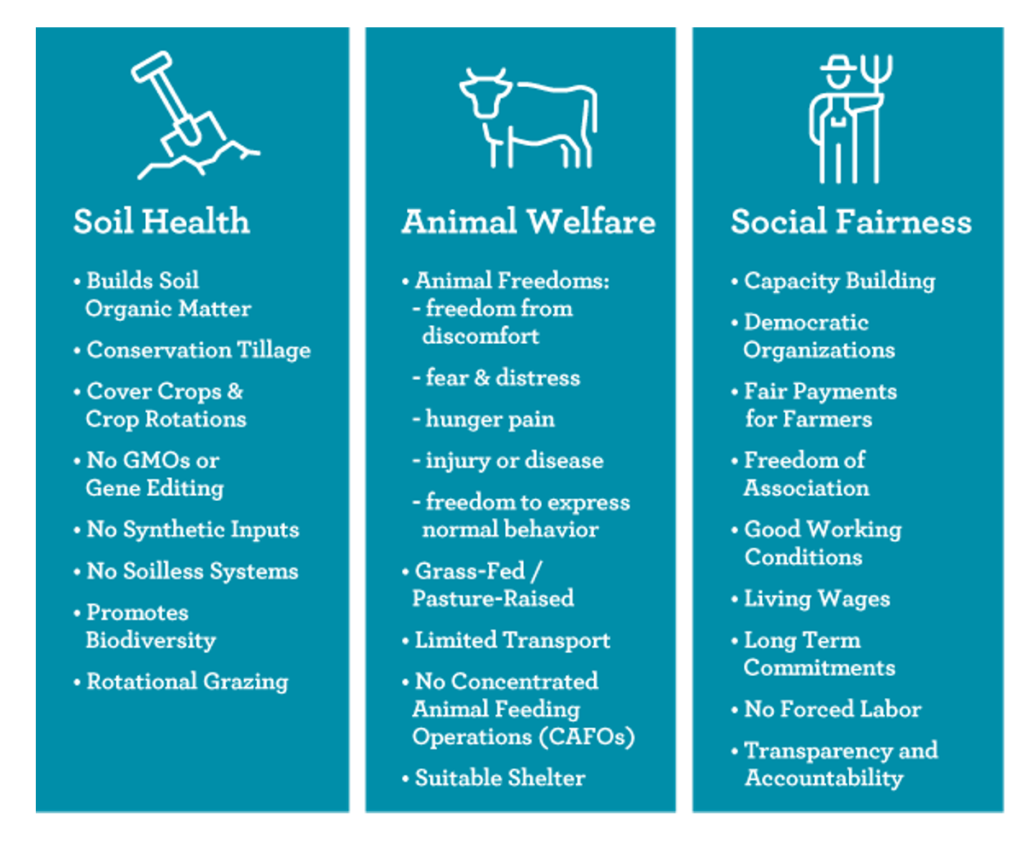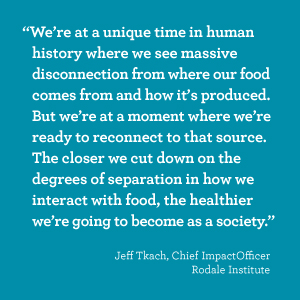Remember when ‘organic’ products first started popping up in grocery stores back in the early 2000’s? The products were few, largely produce-centric and most consumers were striving to understand what ‘organic’ meant, what made it better and why it was more costly. Little did we know that roughly two-decades later ‘organic’ would become ubiquitous, and all but ‘cost of entry’ for gaining distribution in some national retail chains.
Today we now find newer, synonymous terms like ‘ethically sourced’ and ‘sustainable’ finding their way into our everyday nomenclature. Moreover, consumers have come to understand that produce grown under the robust USDA Organic Certification process means not only better food for those consuming it, but that farms engaging in these standards are part of a collective effort to create a better environment. Still, there is an even more beneficial farming method that is emerging on the scene that goes beyond the sustainable organic approach. It’s called regenerative organic farming – a philosophy and practice that is gaining steam and that we all need to be aware of as marketers and demanding consumers.
What is Regenerative Organic Farming?
In a nutshell, regenerative organic farming is about using the natural cycles of ecosystems (totally void of any chemicals) to restore balance to soil and plants and the health of livestock and other animals in and around these farms. It’s a practice that indigenous peoples utilized for centuries. Before European settlers arrived in North America, the Iroquois tribe used intercropping, which entails understanding each crop’s needs and how it can grow symbiotically with the crops surrounding it.
Regenerative organic farming is different from its cousin– sustainable organic agriculture. Sustainable farming is meant to ‘sustain’ or manage agriculture to continue long-term without disrupting the environment. While a step in the right direction, sustainable farming doesn’t go as far as regenerative, whose goal is to ‘regenerate’ the environment (or soil) instead of simply maintaining it. Coined by Robert Rodale of the Rodale Institute in the early 1980s, regenerative organic became the industry term that played a role in his 1970s vision of community farms meant to fulfill local food demand.
There are three pillars upon which regenerative organic farming rests and is guided, with these including:
- Soil Health – Regenerative organic farming is focused on making soil more carbon-rich to yield more nutritious food and more fertile to provide crops with ample opportunity to thrive. It involves alternating crops from season to season to ensure nutrient dispersion and absorption by any one crop is mitigated and that the number of pests and diseases are also reduced by constantly upsetting their food source through crop rotation. And it does all this without the need for chemicals.
- Animal Welfare – Livestock grazing creates another way for the soil to recycle nutrients and distribute manure more evenly as a natural fertilizer without concerns for chemical run-off into water sources. Grazing also serves to improve root systems, creating richer soil. Regenerative Organic Certification also requires that all livestock farms provide a good quality of life for their animals for the regenerative cycle to properly function.
- Social Fairness – The final pillar includes practices involving the agricultural industry’s human element – namely, that farm workers must be treated with respect and their wellbeing must be ensured, providing for a transparent and accountable operation.

Why is this important?
So, what does this all mean and why should food producers and consumers care? It all began with a consistent increase in the world’s population, which prompted the need for more food production. With pressure to increase food production yield, years of conventional farming stripped nutrients from the soil and use of chemicals was spawned in the name of helping to fuel crop growth in the nutrient suppressed soil. To find more fertile land, farmers also razed forests, which in turn, brought with it green-house gas emission implications. What has resulted is rapidly eroding soil quality and diminishing levels of nutrient rich topsoil, placing future food production at risk and reliance on genetically modified food and more chemicals even greater.

Today, farmers, consumers, and brands are beginning to understand the impact and importance of regenerative organic farming on a global, regional and local level. According to Jeff Tkach, Chief Impact Officer at Rodale Institute, “We’re at a unique time in human history where we see massive disconnection from where our food comes from and how it’s produced. But we’re at a moment where we’re ready to reconnect to that source. The closer we cut down on the degrees of separation in how we interact with food, the healthier we’re going to become as a society.”
The List of Passenger Brands Getting on-board is Growing
A number of CPG brands, both large and small, are already partnering with regenerative organic farming to be part of the solution of better food and better earth. Brands like Patagonia and Annie’s Homegrown got in on the game early and have whole-heartedly embraced the regenerative philosophy. Patagonia joined forces with the Rodale Institute and 2,000 farmers from India to create a clothing line that supports regenerative organic cotton farming. Annie’s, which manufactures an array of organic food products sourced from regenerative farms, utilizes its public platform and brings awareness to the subject.
Just recently, a consortium of 12 large food companies, including Mars, PepsiCo and McDonald’s, announced a plan to increase use of regenerative farming that was released just days before the 27th Conference of the Parties to the United Nations Framework Convention on Climate Change (COP27) in Egypt this November. General Mills has also agreed to fund $3 million to convert 1 million acres of farmland for regenerative purposes by 2030. There is also a plethora of small brands which are actively pursuing regenerative sourced ingredients.
Brand willingness to adopt and ‘push’ regenerative farming is essential for helping the world transition to a better, sustainable, environmentally supportive approach for food production. However, it ultimately will take the ‘pull’ of the consumer for this movement to grow roots and thrive.
What Does This All Mean for CPG Brands?
Today’s shoppers (particularly Millennials and those younger) are becoming increasingly more likely to support companies whose values align with their own. They also seek brands committed to social and environmental causes in ways that extend well beyond words – that are steeped in true mission. That said, brands truly immersed in the regenerative movement have an opportunity to build consumers’ trust in their business, with the promise of being rewarded with unwavering customer loyalty in the future. These same brands also have a responsibility to lead the regenerative movement and pull consumers into the fold for a better world.
Given that only 1 in 5 US shoppers have heard of regenerative farming, it is critical that the very brands committed to this movement begin investing in educating consumers on the value that these farming practices deliver. The consortium of brands that presented their plan in advance of COP27 2022 comes to mind as an ideal group to lead the way by collaboratively sharing a simple, yet arresting message about the benefits of regenerative farming in a way consumers can easily understand. Waging a collective information campaign that includes digital media, PR, organizational and governmental council support, speaker programs in schools and communities, and brand partnerships, etc., will clearly serve as an essential first step not just for building awareness, but for forming an emotional connection in the minds of consumers for why this all matters.
Regenerative organic agriculture is not just a good practice– it’s a vital necessity for farms, brands, and consumers to adopt. However, it will take brand commitment, responsibility and trust to turn this spark of a movement into a flame. Together, one conscious consumer at a time, we can leave the earth better than we found it.
As a full-service agency driven to provide leading insights, sales growth and brand building ideas, Ignite2X invites you to contact us to talk about how we can help ignite your brand to its full 2X potential. Click here to schedule a no-obligation e-meeting with us to embrace what’s possible!
SOURCES:


